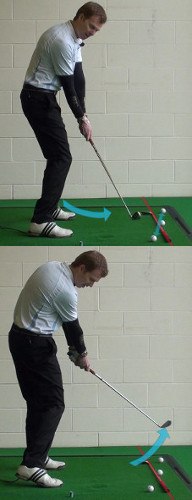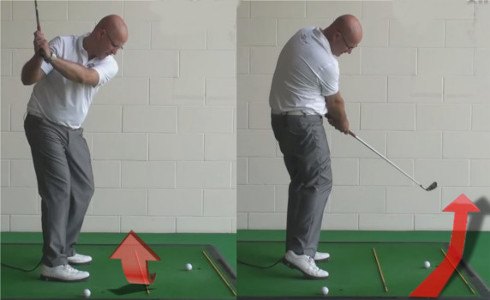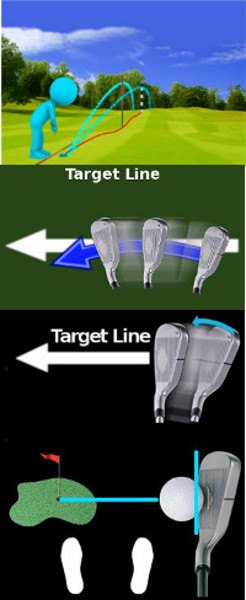
Here's a simple truth: If you want to become a good golfer, you must learn to swing the club on an inside-to-outside path.
The inside-out path is preferable to the outside-in swing, or even a clubhead traveling directly down the target line at impact. Among other reasons, an inside-out path is nearly slice-proof, enables you to hit a draw and transfers more energy to the ball, boosting your power.
Virtually every pro golfer and most low-handicap amateurs swing this way. That includes golfers who favor hitting a fade, such as Jack Nicklaus.
The vast majority of golfers, on the other hand, swing outside-to-in, aka over-the-top. That's usually because they either overuse the arms in relation to the body, or fail to transfer weight properly on the backswing and downswing.
It takes time, effort and a basic understanding of swing mechanics to master the inside-out swing – but if you aim to achieve a single-digit handicap and play consistently solid golf, it's a necessary investment.
Watch these videos for tips on developing a proper inside-to-outside swing:

Why and How to Deliver the Golf Club from Inside the Target Line
The path that the golf club takes into the ball is extremely important when it comes to determining the final destination of the shot. Countless golfers struggle with a poor swing path, and they pay the price in the form of off-target results. Of course, the most-common mistake in the amateur game is the slice, which is usually the result of a swing which comes into the ball from outside-in. Countless golfers deal with a slice for their entire life on the course, simply because they are unable to correct their errant swing path.
In this article, we are going to talk about swinging the club from the opposite direction. Instead of coming across the ball through the hitting area, we are going to suggest that you swing from the inside-out. There are many benefits to this method, which we will touch on later in the article. Once you learn how to swing from the inside-out properly, you will be surprised to find just how powerful and consistent your game can become.
It should be noted right away that this is one of the most-difficult changes you can make to your game. If you are comfortable with swinging across the ball from outside-in at the moment, it is going to be rather strange to approach the ball from the other direction. Making this change successfully is going to require plenty of hard work and patience. There will be struggles along the way, and your game might even get worse before it gets better. To succeed, you'll need to focus on the long term benefits and be willing to sacrifice the state of your game in the short term. In the end, however, you will be glad you stuck it out when you are able to hit the best shots of your life.
All of the content in this article is written from the perspective of a right-handed golfer. If you happen to play left-handed, please take a moment to reverse the directions as necessary.

The Benefits of an Inside-Out Delivery
As mentioned above, it is going to take some time to learn this move, especially if you have a significantly outside-in path at the moment. So why would you go through all of the hard work and frustration required to make this change? That is what we are going to discuss in this section. We feel that it is best to provide you with some motivation upfront before you get started with this process. Then, when the going gets tough and you are struggling to find your way on the practice range, you can remember these benefits and stick it out until you reach your goals.
The following points highlight the key benefits of swinging the club through the ball on an inside-out path.
- Added power. This is the main reason golfers are persuaded to make the switch to an inside-out swing path. When you deliver the club on this path, you should be able to both create more power and transfer more of that power into the golf ball. When you swing down from the outside, you are forced to use mostly your arms and your hands to propel the club through the hitting area. This is not a recipe for power. On the other hand, a swing which moves from inside-out is able to use body rotation more effectively, forcing the club through the ball with authority. As soon as you are able to adjust your path and successfully swing from inside-out, you will likely notice a significant difference in the way your shots feel coming off the club. When you strike the ball just right after coming down on an inside path, there are few feelings better in the world of golf.
- Controlling your trajectory. We already mentioned that the slice is a common outcome when swinging across the ball from outside-in. However, even if you don't hit a slice with your current swing path, you might not have as much control over your trajectory as you would like. Swings that move across the ball on an outside-in path tend to create a high rate of backspin, which is not always a good thing. Plenty of backspin is fine on short iron shots, but it can make your longer shots very difficult to control. Using an inside-out path is going to flatten your angle of attack through the ball, letting you hit a neutral shot that is easier to keep on target. You can still use other methods to hit the ball higher when you would like, and you can even bring the ball down lower more easily when the situation calls for such a shot. Playing good golf is all about controlling your ball as you move around the course. Using an inside-out path is going to make it much easier to do just that.
- Add variety to your game. When you swing from outside-in, your options are limited in terms of the shot shapes you can create. You will naturally hit a fade/slice, and that is the pattern you'll see on most of your shots. Also, you could hit a pull if you use your hands actively to close down the face at impact. For most players, that will be just about it. Those are really the only shots you will see consistently leaving your club face when you swing from outside the line. The story is quite different when you swing from inside-out. You should have little trouble hitting a draw from this position, of course, as swinging out through the ball is the perfect way to impart draw spin. What you might not know, however, is that you can still hit a fade with this type of swing. In fact, this just might be the best way to create a controlled, powerful fade. If you swing through on an inside-out path with the club face slightly open in relation to the swing path, a fade will be the result. Most of the time, when you see a professional golfer hit a fade, this is the way it was created. It will take time and practice, but you can learn how to hit fades and draws on command when you play with an inside-out path.
Once you gain an understanding for the importance of this type of swing path, you will be easily convinced that this is the best thing for your game. It might not be easy to learn how to swing from inside-out, but clearing this hurdle and mastering this move is one of the best things you can do for the improvement of your play. The vast majority of quality golfers are able to swing along this path, and you should strongly consider doing the same.

Getting Started
With a challenge this significant, it is hard to know where to get started. Fortunately, there is a place you can start which will help to set you up for success as you move along – your address position. By working on your address position right at the start of this process, you can check it off as a point of concern. It is hard enough to hit good golf shots when you have a great stance working for you – without a good stance, you have almost no chance.
So what is it about your address position that will help you swing along an inside-out path? Check out the following tips for help.
- As square as possible. Before you walk up to take your stance, you should have picked out a target line for the shot at hand. That imaginary line is going to serve as your point of reference when you create your stance. Everything that makes up your stance should be as square as possible to that chosen target line. That means your feet, knees, hips, and shoulders should all be equidistant from the line you are using for the shot. Building a perfectly square stance is a great way to leave all of your options open during the swing. Unfortunately, many golfers set up in a way that naturally promotes an outside-in swing. Many amateurs start with their hips and shoulders open to the line, which leads to a takeaway that moves outside the target line. It should be no surprise that these kinds of swings often come back down on that same path, and a slice is the result. If necessary, use a mirror or video recording equipment to check on your stance and make sure you are finding a square position before moving on.
- Healthy knee flex. Another common mistake seen among golfers who hit a slice is using very little knee flex at address. During the golf swing – especially during the downswing – your lower body has a critical role to play. If you fail to flex your knees properly, your legs won't be able to get involved in the action and your swing will be mostly arms and hands. That is bad news, as your arms and hands are almost certainly going to force the club outside the target line on the way down. Without a good lower body turn, your body will actually be in the way of the club if it wanted to take an inside-out path. With that option off the table, the club is going to find its way down to the ball by moving outside and cutting across at impact. Start with your knees flexed and it will be much easier to keep your legs engaged all the way through the swing.
- Relaxed arm hang. The takeaway phase of the golf swing is an extremely important, and often-overlooked part of your technique. We will talk about the takeaway more in the next section, but rest assured that this piece of the puzzle has a prominent role to play. To give yourself the best possible chance at making a clean takeaway, you will want to start with a relaxed arm hang at address. Your arms should be hanging freely from your shoulders, without reaching out or being stuck in close to your body. When viewed from behind, it should be easy to see that your arms are hanging pretty close to vertically. If you are too far off this mark, it will be tough to hit good shots.
To be honest, a solid address position is important for just about every element of your game. Not only is this going to help you swing the club on an inside-out path, but it is simply going to help you play better golf all the way around. Most golfers don't find this to be a particularly exciting element to practice, but you would be wise to work through it for the betterment of your game.






